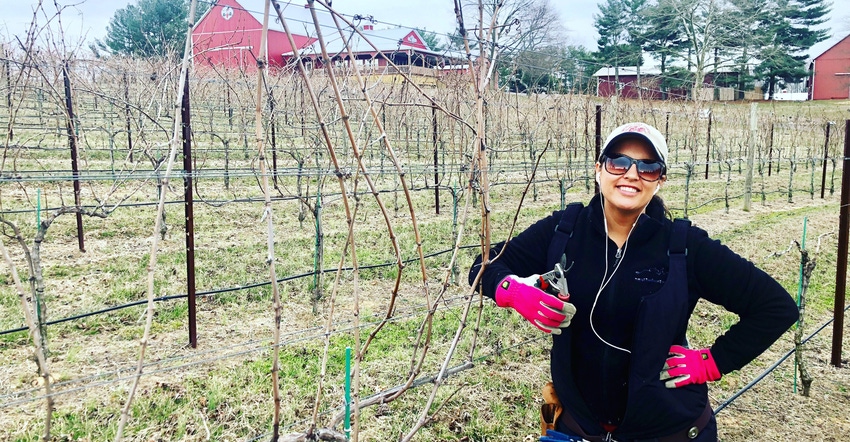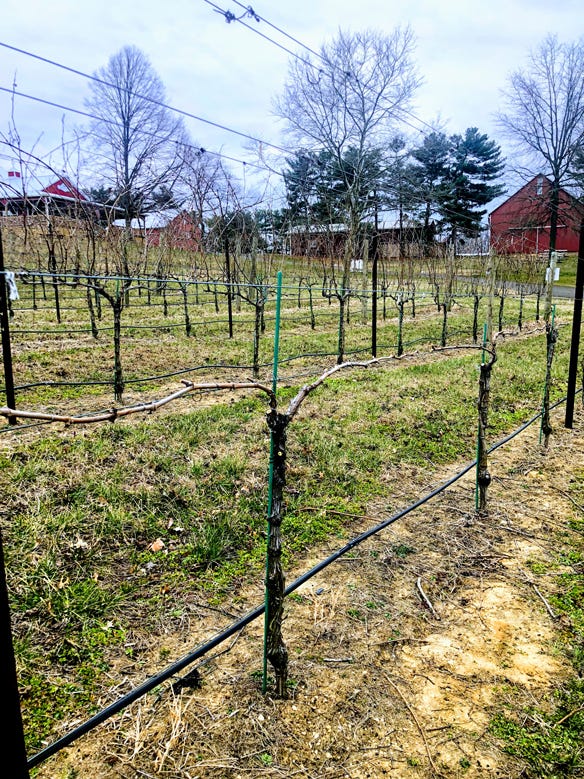March 5, 2021

Our yearly crop cycle for the vineyard kicks off in the dead of winter when we begin February pruning.
Pruning must happen to the vines when they’re hibernating for winter, so we enter the vineyard looking like the kid from "A Christmas Story" who can’t put his arms down — all bundled up in cold weather gear.
I actually prefer winter pruning to summer thinning and tucking. I’d much rather pile on warm clothes and be out in the cold air than sweat profusely in the muggy southern Maryland heat. We experience all of it, though, from ice and 20 degrees F in the winter to 95 degrees and 80% humidity in the summer.
The vines we choose must be able to survive and thrive through both extremes. It all begins in late February as we sharpen the pruners and begin removing the older wood from the vines.
Pruning is one of the most important things we do, as we are setting up the vine not only for the upcoming season, but also for the following season, too. It takes some thinking and deliberation, and we spend a few minutes in front of each vine, as each plant is different.
We do a combination of two pruning methods to reach our goals, spur pruning and cane pruning, and one vine can actually contain a combination of both.
The cordons of the vine are the two main arms that come off the center trunks of the plant and are laid down horizontally over the fruiting wire of the trellis. Every year, we are looking to refresh and shape these cordons through pruning.
For spur pruning, we look at the cordon and decide if we like the layout of it. Does it have a nice shape, good space between the budding nodes and generally look like it will be productive? If so, we can choose to leave the cordon and just trim the canes down into shorter spurs, each containing two budding nodes to grow up into new canes this year.
For cane pruning, we decide we don’t like the look of the cordon. It might not have good node spacing. It might be thin, or it might have grown wonky after it was laid down from the previous season.

READY FOR THE SEASON: You can see immediate results from pruning as you move along from plant to plant and row to row.
In this case, we look farther down the trunk of the vine to the young spare cane we left to grow last season for this particular purpose, or if there is none, we can use one of the tall canes from one of the first spurs closest to the main trunk.
We then take the big lopers and cut off the old cordon completely. After that, we lay down the chosen new cane on the wire, flex it a bit to limber it up and prevent apical dominance — this is called “cracking” because you want to hear the wood crack a little as you flex it — and clip it into place. This cane is now the new cordon of the vine.
Vines have two main trunks, and each has a cordon growing in one direction — one to the left and one to the right. We will follow the pruning process for both sides, and a vine can be completely spur-pruned, completely cane-pruned, or a combination of both on either side.
Once all the prunings are cut and pulled out of the trellis wire, we throw them behind us into piles that we later collect, shred and turn into compost.
To me, this is one of the most satisfying things we do in the vineyard because you can see immediate results as you move along from plant to plant and row to row. My organizational brain loves to look down the row and see neat, clean, trimmed vines where there was previously just a chaotic mess of last year’s old growth.
Of course, pruning comes with its own unique quirks. You have to pay attention to your hands! Don’t grab a vine too close to the clipping point; no one wants to lose a finger.
We also wear safety glasses because the vines like to resist being pulled from that trellis, and you will get slapped in the face multiple times no matter how careful you are. (OK, my husband wears safety glasses. I wear my comfy $12 Target sunglasses, but whatever works, right?)
If you would like to see a video of us winter-pruning, you can check out our episode on FarmHer. We are featured in Season 2, Episode 20, and we take a walk through the vineyard during winter pruning on the segment.
I hope that wherever you are, things are progressing nicely for your operation, too. Here’s hoping for a productive and fruitful year for us all!
Watson-Hampton farms with her family on their fourth-generation family farm in Brandywine, Md.
You May Also Like




